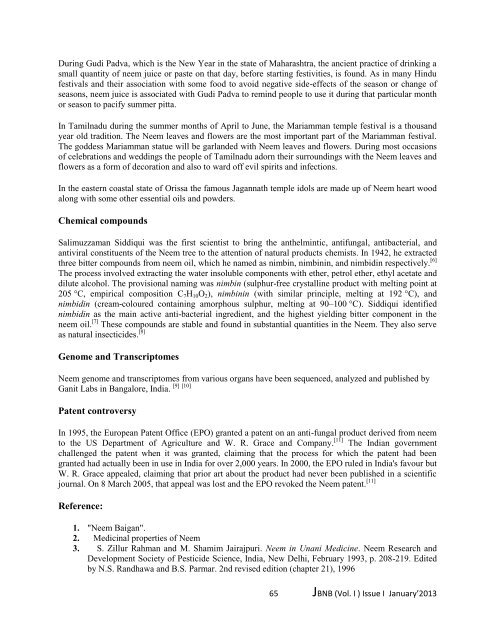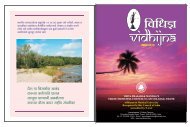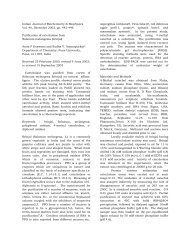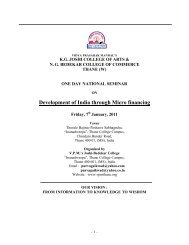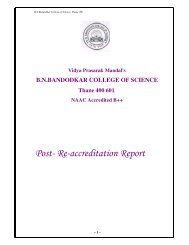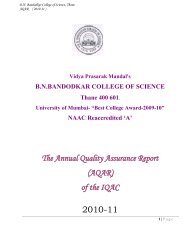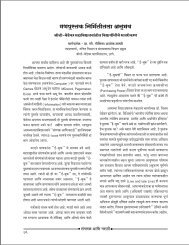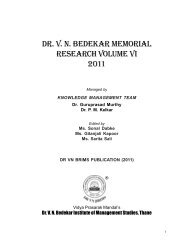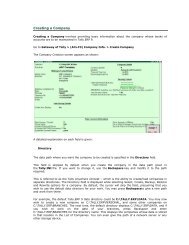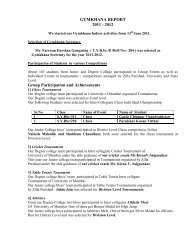J-BNB - VPMThane.org
J-BNB - VPMThane.org
J-BNB - VPMThane.org
You also want an ePaper? Increase the reach of your titles
YUMPU automatically turns print PDFs into web optimized ePapers that Google loves.
During Gudi Padva, which is the New Year in the state of Maharashtra, the ancient practice of drinking a<br />
small quantity of neem juice or paste on that day, before starting festivities, is found. As in many Hindu<br />
festivals and their association with some food to avoid negative side-effects of the season or change of<br />
seasons, neem juice is associated with Gudi Padva to remind people to use it during that particular month<br />
or season to pacify summer pitta.<br />
In Tamilnadu during the summer months of April to June, the Mariamman temple festival is a thousand<br />
year old tradition. The Neem leaves and flowers are the most important part of the Mariamman festival.<br />
The goddess Mariamman statue will be garlanded with Neem leaves and flowers. During most occasions<br />
of celebrations and weddings the people of Tamilnadu adorn their surroundings with the Neem leaves and<br />
flowers as a form of decoration and also to ward off evil spirits and infections.<br />
In the eastern coastal state of Orissa the famous Jagannath temple idols are made up of Neem heart wood<br />
along with some other essential oils and powders.<br />
Chemical compounds<br />
Salimuzzaman Siddiqui was the first scientist to bring the anthelmintic, antifungal, antibacterial, and<br />
antiviral constituents of the Neem tree to the attention of natural products chemists. In 1942, he extracted<br />
three bitter compounds from neem oil, which he named as nimbin, nimbinin, and nimbidin respectively. [6]<br />
The process involved extracting the water insoluble components with ether, petrol ether, ethyl acetate and<br />
dilute alcohol. The provisional naming was nimbin (sulphur-free crystalline product with melting point at<br />
205 °C, empirical composition C 7 H 10 O 2 ), nimbinin (with similar principle, melting at 192 °C), and<br />
nimbidin (cream-coloured containing amorphous sulphur, melting at 90–100 °C). Siddiqui identified<br />
nimbidin as the main active anti-bacterial ingredient, and the highest yielding bitter component in the<br />
neem oil. [7] These compounds are stable and found in substantial quantities in the Neem. They also serve<br />
as natural insecticides. [8]<br />
Genome and Transcriptomes<br />
Neem genome and transcriptomes from various <strong>org</strong>ans have been sequenced, analyzed and published by<br />
[9] [10]<br />
Ganit Labs in Bangalore, India.<br />
Patent controversy<br />
In 1995, the European Patent Office (EPO) granted a patent on an anti-fungal product derived from neem<br />
to the US Department of Agriculture and W. R. Grace and Company. [11] The Indian government<br />
challenged the patent when it was granted, claiming that the process for which the patent had been<br />
granted had actually been in use in India for over 2,000 years. In 2000, the EPO ruled in India's favour but<br />
W. R. Grace appealed, claiming that prior art about the product had never been published in a scientific<br />
journal. On 8 March 2005, that appeal was lost and the EPO revoked the Neem patent. [11]<br />
Reference:<br />
1. "Neem Baigan".<br />
2. Medicinal properties of Neem<br />
3. S. Zillur Rahman and M. Shamim Jairajpuri. Neem in Unani Medicine. Neem Research and<br />
Development Society of Pesticide Science, India, New Delhi, February 1993, p. 208-219. Edited<br />
by N.S. Randhawa and B.S. Parmar. 2nd revised edition (chapter 21), 1996<br />
65 J<strong>BNB</strong> (Vol. I ) Issue I January’2013


